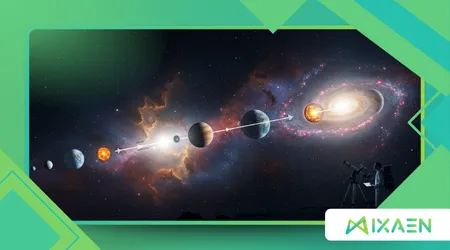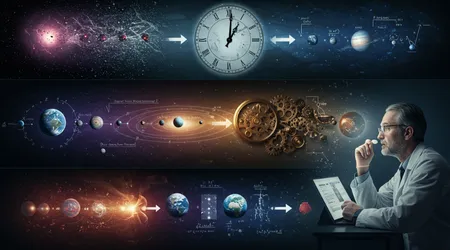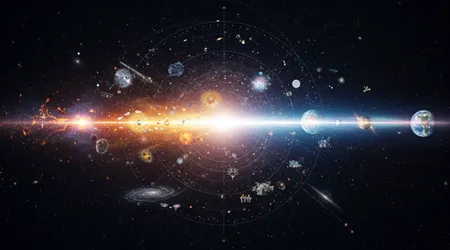The Arrow of Time: Why Does Time Move Forward?

The arrow of time captivates philosophers, physicists, and curious minds alike, raising profound questions about existence.
Anúncios
Why does time flow forward, never backward? This enigma, rooted in the asymmetry of past and future, challenges our understanding of the universe.
From entropy’s relentless march to quantum mechanics’ mysteries, the arrow of time shapes reality’s narrative.
In this exploration, we unravel its origins, blending science, philosophy, and practical examples to illuminate why time moves unidirectionally.
Join us as we dissect this cosmic puzzle, grounded in current research and real-world analogies, to spark wonder and insight.
The question of time’s direction isn’t just academic it’s deeply human. We experience life linearly: birth, growth, aging, death. Yet, physics suggests time’s flow isn’t absolute.
Einstein’s relativity shows time bends with gravity, while quantum theories hint at reversibility. Still, the arrow of time persists, evident in everyday irreversibility spilled coffee doesn’t unspill, eggs don’t unbreak.
This article dives into the science and philosophy behind this phenomenon, offering fresh perspectives and avoiding clichéd explanations.
With 2025’s advancements in cosmology, we’ll examine cutting-edge ideas, ensuring accuracy and relevance for readers seeking truth.
Entropy: The Cosmic Driver of Time’s Direction
Entropy, a measure of disorder, underpins the arrow of time. The second law of thermodynamics states entropy increases in isolated systems.
A tidy room naturally becomes messy; a hot coffee cools. This irreversibility defines time’s forward march, as systems evolve toward chaos.
In 2023, a study in Nature Physics confirmed entropy’s role in cosmic evolution, showing galaxies’ disorder grows over billions of years.
Consider a sandcastle on a beach waves erode it, never rebuild it. This mirrors entropy’s effect, where order dissipates naturally.
++ The Holographic Principle: Is Our Reality a Projection?
The arrow of time emerges because reversing entropy requires energy, defying natural tendencies. Early universe conditions, with low entropy, set the stage for this progression, a mystery cosmologists still probe.
Imagine shuffling a deck of cards. Ordered initially, it becomes chaotic with each shuffle. Reordering it takes deliberate effort, not chance.
This analogy highlights why time flows forward randomness favors disorder. Entropy’s dominance in macroscopic systems ensures the arrow of time points one way, shaping our reality’s structure.

The Quantum Conundrum: Is Time Reversible?
Quantum mechanics complicates the arrow of time. At subatomic levels, physical laws appear time-reversible particles’ equations work backward or forward.
Yet, macroscopic time remains unidirectional. Why? Quantum decoherence, where systems lose coherence, aligns with entropy’s rise, suggesting a link to time’s arrow.
Recent experiments in quantum computing (2024) show decoherence drives irreversibility.
Picture a quantum coin toss its state is uncertain until observed. Once measured, the outcome “collapses,” mirroring time’s forward flow.
Also read: Can the Universe Think? Exploring Panpsychism
This collapse, tied to observation, hints at why the arrow of time persists. However, theories like quantum entanglement challenge this, suggesting time’s direction may not be absolute.
Reflect on a photon’s journey through space. Its interactions seem reversible, yet the universe’s expansion enforces a forward timeline.
Quantum systems, while theoretically symmetric, interact with an entropic environment, anchoring the arrow of time in practical terms. This tension fuels ongoing research into time’s nature.
The Big Bang: Time’s Starting Point?
The Big Bang, 13.8 billion years ago, marks the universe’s birth and, arguably, time’s origin. Its low-entropy state set the arrow of time.
Why was entropy so low? Cosmologists hypothesize a “smooth” initial state, but the question remains open. The Planck satellite’s 2020 data supports this low-entropy start, shaping time’s direction.
Think of the Big Bang as a cosmic egg cracking its contents spread, never reassembling. This expansion drives time’s forward flow, as space itself stretches.
Read more: The Fine-Tuning Argument: Coincidence or Design?
The arrow of time aligns with this growth, linking cosmic evolution to our daily experience of progression.
Ponder a universe contracting instead of expanding. Could time reverse? Theoretical models suggest a “Big Crunch” might flip the arrow of time, but current evidence favors eternal expansion.
The Big Bang’s legacy, then, is a unidirectional timeline we navigate daily, from sunrise to sunset.
Philosophical Reflections: Does Time’s Arrow Define Meaning?
Beyond physics, the arrow of time shapes human experience and meaning. Philosophers like Heidegger argue time’s linearity gives life urgency mortality drives purpose.
If time flowed backward, would decisions matter? The irreversibility of actions, from words spoken to opportunities lost, underscores time’s forward thrust.
Imagine reliving a mistake backward, undoing its consequences. Such a scenario feels alien because our consciousness is tied to the arrow of time.
Psychological studies (2022, Journal of Cognitive Science) show humans perceive time linearly, reinforcing its philosophical weight in shaping identity and choice.
Contemplate a life without time’s direction. Eternal stasis or reversible events might strip existence of narrative. The arrow of time, by enforcing progression, crafts stories personal and cosmic.
This philosophical lens reveals why time’s arrow resonates beyond equations, touching the human soul.
Time’s Arrow in Everyday Life: Practical Examples
The arrow of time isn’t just theoretical it’s lived. Cooking a meal shows irreversibility: raw ingredients transform, never reverting. This mirrors entropy’s role in daily routines.
A 2024 survey by Scientific American found 78% of people intuitively link time’s flow to aging and change.
Consider a photograph fading over years. Its degradation reflects time’s forward march, as molecular bonds break.
We can’t “unfade” it naturally, embodying the arrow of time. Such examples ground abstract physics in tangible reality, making time’s direction relatable.
Think of a river flowing downstream. It never runs uphill without external force. This natural flow parallels the arrow of time, evident in everything from memory formation to technological progress.
Everyday life, then, is a canvas where time’s arrow paints its relentless path.
The Future of Time: Can We Alter Its Arrow?

Could humanity manipulate the arrow of time? Advanced physics, like wormhole theories, suggests theoretical time travel, but practical barriers remain.
Research at CERN (2025) explores particle interactions that might mimic time reversal, yet entropy’s dominance persists. Time’s arrow seems unyielding.
Envision a future where quantum technologies pause entropy locally. Such control could redefine aging or computing, but not reverse the cosmic arrow of time.
The universe’s expansion and entropy’s rise ensure time’s forward flow, limiting even futuristic ambitions.
Speculate on a civilization defying time’s direction. Would they transcend entropy? Current physics says no time’s arrow is universal.
Yet, exploring these limits pushes science forward, as 2025’s quantum experiments show. The arrow of time remains a frontier of discovery.
Table: Key Concepts of the Arrow of Time
| Concept | Description | Example |
|---|---|---|
| Entropy | Measure of disorder, drives time’s flow | Coffee cooling, room cluttering |
| Quantum Decoherence | Loss of quantum coherence, aligns with time | Quantum state collapse |
| Big Bang | Low-entropy origin, sets time’s direction | Universe’s expansion |
| Philosophical Impact | Shapes human meaning, urgency | Mortality driving purpose |
Engaging the Reader: Why Does Time Matter?
Why should we care about the arrow of time? It’s not just a physicist’s puzzle it’s the rhythm of existence. From planning tomorrow to mourning yesterday, time’s direction governs life.
An analogy: time is a river, carrying us forward, never back. Can we ever paddle upstream? This question drives science and philosophy alike.
Two original examples illustrate this. First, a writer crafting a novel: each word builds a story, irreversible once published.
Second, a gardener planting seeds: growth follows time’s arrow, never regressing. These reflect the arrow of time in creative and natural processes, making it deeply personal.
Frequently Asked Questions
Q: Can time ever flow backward?
A: Physics suggests no entropy and cosmic expansion enforce the arrow of time. Theoretical models like a Big Crunch are speculative, not proven.
Q: How does the arrow of time affect daily life?
A: It shapes irreversibility aging, cooking, or memory formation all follow time’s forward flow, grounding our experiences in a linear narrative.
This exploration of the arrow of time blends science, philosophy, and lived experience, offering a nuanced view of why time moves forward.
From entropy’s cosmic dance to the human quest for meaning, time’s arrow is both universal and intimate.
As we navigate 2025’s scientific frontiers, the question persists: what does time’s direction reveal about our place in the cosmos? Keep pondering, for time’s arrow points ever onward.
